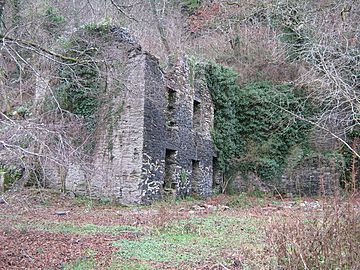New Quay (Devon) facts for kids
| UNESCO World Heritage Site | |
|---|---|

Abandoned building at New Quay
|
|
| Location | Gulworthy, West Devon, Devon, United Kingdom |
| Part of | "Tamar Valley Mining District" part of Cornwall and West Devon Mining Landscape |
| Criteria | Cultural: (ii)(iii)(iv) |
| Inscription | 2006 (30th Session) |
New Quay is a small, old abandoned village and busy mining port. It sits on the steep banks of the River Tamar in Devon, England. New Quay is just east of Morwellham Quay, which is now a museum. This area was once very important for mining.
New Quay was a key port for shipping valuable metals. These included copper, tin, and later arsenic. These materials came from nearby mines like the George and Charlotte Mine, Bedford Consolidated Mine, and Gawton Arsenic Mine. Since 2006, New Quay has been part of a special place. It is now a World Heritage Site, known as the Cornwall and West Devon Mining Landscape.
A Look Back in Time
New Quay has a rich history tied to mining. The closest mines to the port were the Gawton Arsenic Mine, the Bedford Consolidated Mine, and the George and Charlotte Mine. The Gawton Arsenic Mine is a "scheduled ancient monument." This means it is a nationally important historical site. Across the river was the Harewood Consolidated Mine. On the high ridge to the east, you could find other mines. These included Tavy Consolidated Mine, East and West Liscombe, and Wheal Tamar Copper Mines. The William and Mary Mine was also in this area.
The whole New Quay area was part of the parish of Gulworthy. This was a small farming area that grew because of mining. Many mining families lived here. Some went to the main church, while others went to different Protestant churches.
The Tavistock Canal's Role
New Quay also benefited from the Tavistock Canal. This canal was a big engineering project for its time. It joined the River Tamar at Morwellham Quay. The canal was finished in June 1817. It included a long tunnel, about 1.75 miles (2.8 km) long. Building it cost a lot of money, around £68,000. This was a huge amount back then. The canal helped transport ores from the mines. It was a remarkable achievement. However, its importance started to decline in the 1860s.
In 1818, people said the River Tamar was deep enough for ships. Vessels of about 130 or 140 tons could reach New Quay. Larger ships, with a fourteen-foot depth, could go up to Morwellham Quay. This was about six miles from Plymouth.
New Quay Today
The village of New Quay was abandoned in the early 1900s. Over time, it became overgrown with plants. Some of the large stone blocks from the quay were even stolen. But in 2008, work began to save New Quay. Many of the old buildings were made stable and repaired. A lot of the thick undergrowth was cut back.
Today, you can visit New Quay. Trains on the old mine tramway from Morwellham stop here. Local guides can show you the old structures. They explain what mining and life were like in the valley. You can also visit the site on foot without a guide. More public access is planned for the future.


